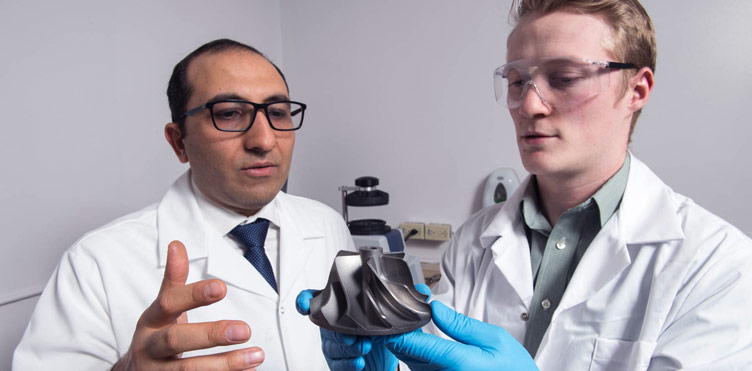Our research

Acoustics and vibrations
Research is conducted in the area of flow-induced vibrations where structures are exposed to fluid excitation such as turbulent pressure fluctuations, flow periodicity, or fluidelastic instability. Applications of this research area include nuclear steam generators, nuclear fuel assemblies, and acoustic-induced vibrations in valves and pipelines.
Biomedical
Mechanical biomedical engineering at UNB involves extensive collaborations with kinesiology, electrical and computer engineering, the MRI Centre and the Institute of Biomedical Engineering. Interests include imaging, biological signal processing, biomechanics, and ergonomics with well-equipped laboratories in all areas.
Bioenergy and bio products research lab
Dr. Muhammad T Afzal leads research in bioenergy and bio products. Research focuses on feedstock processing and engineering, pellets, briquettes, modelling of compaction phenomena and thermo-mechanical characterization, and biofeedstock management including its storage, drying, modelling and logistics.
Dr. Afzal and his team are focusing on design and development of novel technologies to produce renewable fuels, chemicals and value-added products and materials, process modeling and optimization, which can find application in automotive, food, chemical, health and pharmaceutical industries.
Ongoing research activities include development of innovative technologies such as microwave to process and convert renewable feedstock into fuels, heat, power and bio-products, modeling and simulation of real-time process.
Manufacturing and materials processing
Research is done developing intelligent controllers for applications in polymer processing and robotics. This research program involves formulating artificial neural networks and process-modeling techniques, deriving advanced control schemes in realtime and practical implementations. Other applications include magnetic levitation and flexible manipulators.
Mechatronics and design
Mechatronics design is mechanical engineering for the 21st century.
Drs Dubay and Hassan's research in this area is devoted to the control, modelling of system dynamics and design challenges associated with the fields of active vibrations control of space structures and structures subjected to fluid flow.
Nanocomposites and Mechanics Laboratory
Dr. Gobinda Saha’s Nanocomposites and Mechanics Laboratory (NCM Lab) is working in the field of advanced materials design, manufacturing, testing/characterization, and modeling to develop innovative solutions to tackle industrial wear and premature material failure facing structural and non-structural components. The research and development work is currently focused on developing (a) high-strength high pressure cold sprayed coatings and additive manufacturing components based on nanostructured cermet composite materials, (b) smart biocomposites by integrating biofibers with structural glass/carbon fibre-reinforced polymer materials embedded with sensors and/or actuators, and (c) multifunctional materials and coatings by advanced sol-gel processes. The work is fundamentally linked with industry needs.
Renewable energy systems
The University of New Brunswick is collaborating with Atargis Energy Inc. to develop a novel, lift-based wave energy converter with improved storm survivability and hydrodynamic efficiency.
Among alternative energy sources, wave power is one of the most abundant untapped sources on earth. The World Energy Council has estimated the worldwide annual amount of wave power energy at 17.5 PWh. This is comparable to annual worldwide electric energy consumption, which is currently estimated at 16 PWh. Wave power has the potential to provide a large portion of the world's electric energy needs if it can be tapped efficiently.
Robotics and applied mechanics
Recent work includes the study of parallel manipulators and the simulation of robotic systems. Study in the area of parallel manipulators is focused on improving the workspace characteristics (such as the size, quality, and force-moment capabilities) using kinematic and actuation redundancy. Kinematic calibration methods and creation of complete kinematic models are of interest especially for reduced degree-of-freedom manipulators.
Thermofluids and aerodynamics
Fluid mechanics research at UNB includes both experimental and computer simulation of practical technological problems facing industry and society. These include the experimental study of airframe generated noise, submarine manoeuvres and control. This also includes liquid sprays for pesticide application steam turbine irreversibility resulting from homogeneous condensation, vibration of mixing impellers in polymer reactors, surface cooling with high-speed jets and continuous casting of metals.
